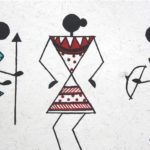The wounds inflicted on India’s secularism and democracy by the demolition of the Babri Masjid 25 years ago are still raw. The Babri Masjid demolition from a Constitutional point of view is not a mere chapter in a property dispute. The struggle for justice for the Babri Masjid demolition will never be forgotten or abandoned. The perpetrators of the demolition must be punished – and their successors today must be prevented from demolishing secular, democratic India and replacing it with the fascist project of majoritarian mob rule.
An art Exhibition was held to mark the 29th Safdar Hashmi Memorial. It was an annual event, organised by Sahmat, a trust constituted in the memory of the theatre director. It was inaugurated on the first day of the new year. For over 29 years now, January 1 has been an important date on the Delhi calendar. What began as a spontaneous coming together of artists of different hues, vocations and inclinations has become, arguably, the most prominent annual cultural and political event in the city. Routinely, the colourful drapes and banners adorned the otherwise dreary built structures of VP House. The events organised by Safdar Hashmi Memorial Trust to commemorate the memorial of the Great Theatre artist Safdar Hashmi.

Exhibition narrating the bloodshed, politics and conflicts of Babur Masjid
The exhibition had one wall narrating the history of a city marred by bloodshed, politics and conflict, another wall showcased landscapes of dissent, and the third acquainted us with the faces of struggle. Three exhibitions adorned the walls of the Constitutional Club annexe in Delhi. The annual event marks the attack on the group of street theatre activists on January 1, 1989, which claimed Hashmi’s life. This year the trust is also commemorating the 25th anniversary of the demolition of Babri Masjid in Ayodhya.

Events at the Safdar Memorial
The first exhibition, ‘Hum Sab Ayodhya’, was curated 25 years ago in Ayodhya and had travelled to 16 cities. The exhibition is sensitively conceived and aesthetically designed and has been researched by reputed historians and mounted by well-known artists, designers and art historians. It is a tribute to the history, culture and civilization of Ayodhya and its people. Among the 83 exhibition panels in the display is a 4-page text titled ‘Ram Katha’ which depicts the Rama legend as the common heritage of several religious and secular traditions.
The manner in which one particular sentence from here has been pulled out of context and indecently interpreted has dismayed and hurt the sentiments of all sensitive citizens. Billed as the largest-ever voluntary collaboration of artists of different genres, it traces the history and plurality of the ancient city. “Bajrang Dal had attacked the exhibition then and got a part of it banned,” recalls historian Sohail Hashmi, “And we went to court.” The panel in question traced the history of the epic Ramayana in India.The ban was ultimately lifted.
The exhibition takes us through the history of the Ayodhya-Faizabad region, its place as a pilgrim site, travellers’ accounts, the significance of the town in various religions, and its architecture. In translation was a 700-year-old ghazal written by Amir Khusrau on the city, where he had spent two years of his life. “A town it is, but what a town, a garden,” he writes.

Exhibits of artists on display at the safdar Memorial
A month ago, a call was made to artists around India, to explore the violent manifestations that have taken place after the Babri Masjid demolition. Marking the 25th anniversary of the Babri Masjid Demolition, was an exhibition titled “Beyond Disputes: Landscapes of Dissent”. It featured works by over 40 artists. The destruction of the 16th-century mosque in the holy town of Ayodhya in the northern Indian state of Uttar Pradesh was a seminal event in the relationship between Muslims and Hindus in India, who say the site where the mosque stood is the birthplace of Lord Ram.
In the communal violence that ensued after the mosque was razed to the ground, hundreds died, and the secular fabric of modern India was thrown into jeopardy. Taking all the events into consideration a curator, 28-year-old, Aban Raza, talked about her lithograph, where she writes the first of the iconic slogan: ‘Ek Dhakka Aur Do, Babri Masjid Tod Do’. “When I speak to people who witnessed the demolition, I feel the resonance even today,” she says. ‘Who am I? A Hindu, A Muslim, A Sikh, A Christian or A Human’, asks a poster by Vibha Galhotra, while Rahul Aggarwal Shorewala, in another, asks, ‘How long can we tolerate?’.
In the exhibition, ‘The Parched Earth’, taking forward the idea of struggle and apathy of the farmers, photographer Ram Rahman brings together their portraits, farmers who had come from across the country to protest at Jantar Mantar last year.”The Parched Earth”, showed portraits of peasants and farmers from across the country taken by college students associated with Rahman.
Beside this exhibit, was poet-photographer Mahender Singh Bisht poem, Rosh, where he vents his anger about the ignorance of the farmers by the privileged. Filmmaker Virendra Saini “Ayodhya” was also screened focussing on the city’s life and an underlying message – “Ayodhya belongs to everyone”. Madan Gopal Singh, singer-composer, said that for the last 29 years Sahmat has tried to keep alive what Safdar had started.
“It’s all about Safdar. Safdar believed art belongs to the masses and everyone was his friend. He wrote a lot, he did so many plays. And it was always about the common people, the labourers and communal harmony,” he said.

Artwork at the “Hum Sab Ayodhya”
This whole Exhibition organized by the Safdar Memorial trust to remember the great artist and to commemorate the 25 the anniversary of the demolition of Babri Masjid was a huge success with people all over coming down to witness the works of various Indian artists.



What do you think?